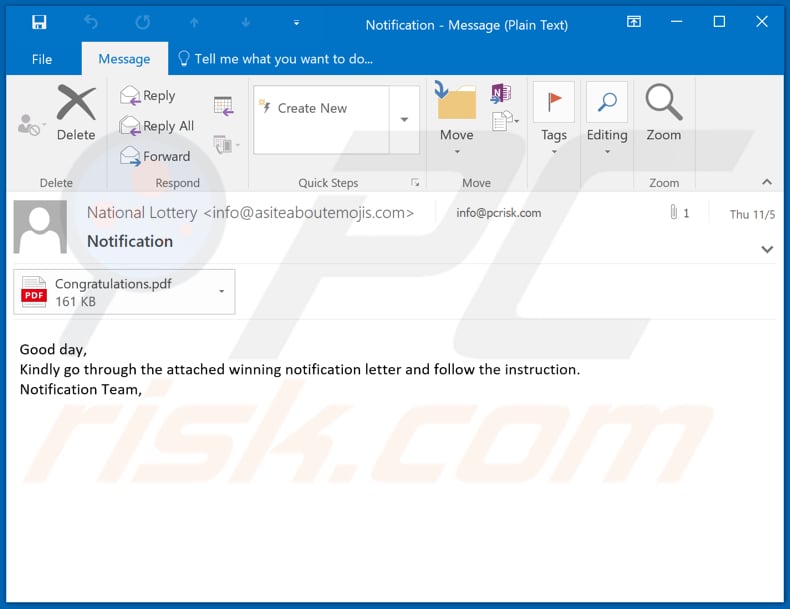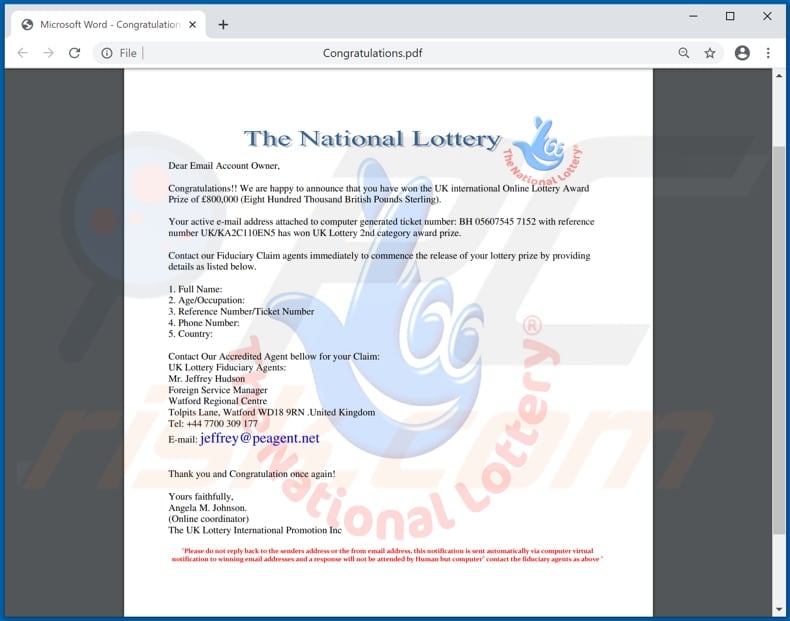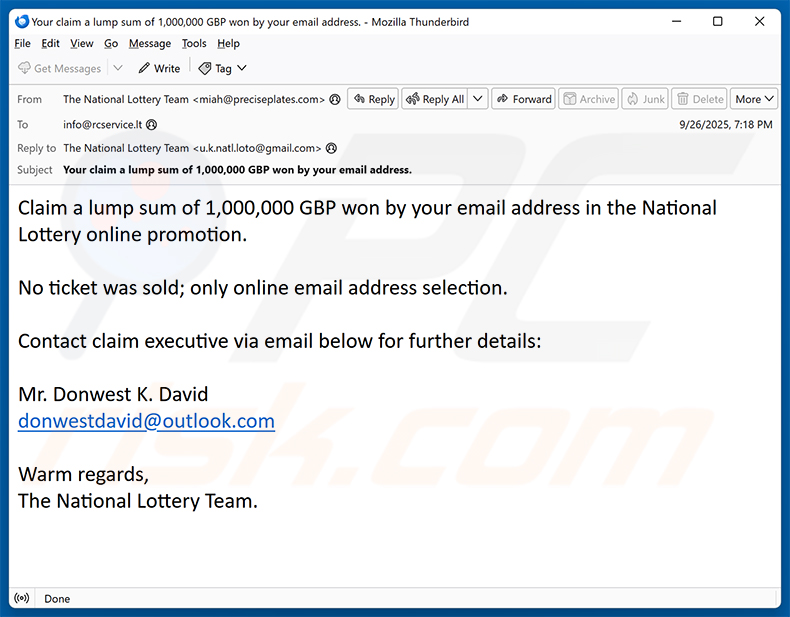Get free scan and check if your device is infected.
Remove it nowTo use full-featured product, you have to purchase a license for Combo Cleaner. Seven days free trial available. Combo Cleaner is owned and operated by RCS LT, the parent company of PCRisk.com.
What is "National Lottery email scam"?
Scammers behind lottery scams send notifications stating that the recipient has won some money or another prize. Typically, they send such notifications via email, text messages, and social media.
They exploit names of existing lottery companies/organizations to deceive users into believing that their scams are legitimate. Scammers use these methods to extort money and personal information.

"National Lottery email scam" overview
The scammers behind this particular scam use email as a way to distribute it. They send emails that are disguised as messages from The National Lottery (national lottery in the United Kingdom) with a PDF document attached to them, which supposedly contains instructions about how to claim the prize.
The attached PDF document states that the recipient has won a prize of £800,000 (GBP), which can be claimed by providing details such as full name, age, occupation, telephone number, and country via email address (jeffrey@peagent.net) or the +44 7700 309 177 telephone number.
When contacted, scammers ask victims to pay a fee, supposedly for insurance, or transfer charges, bank fees, etc. They might also ask for private, sensitive information such as bank account details. In any case, lottery (and other) scams such as this should never be trusted. Note that most legitimate lotteries do not ask winners to pay any fees to collect their winnings.
| Name | National Lottery Email Scam. |
| Threat Type | Phishing, Scam, Social Engineering, Fraud. |
| Fake Claim | Recipient has won a prize in the lottery. |
| Disguise | Winning notification from The National Lottery. |
| Scammer's Telephone Number | +44 7700 309 177 |
| Scammer's Email Address | jeffrey@peagent.net |
| Symptoms | Unauthorized online purchases, changed online account passwords, identity theft, illegal access of the computer. |
| Distribution methods | Deceptive emails, rogue online pop-up ads, search engine poisoning techniques, misspelled domains. |
| Damage | Loss of sensitive private information, monetary loss, identity theft. |
| Malware Removal (Windows) |
To eliminate possible malware infections, scan your computer with legitimate antivirus software. Our security researchers recommend using Combo Cleaner. Download Combo CleanerTo use full-featured product, you have to purchase a license for Combo Cleaner. 7 days free trial available. Combo Cleaner is owned and operated by RCS LT, the parent company of PCRisk.com. |
Similar spam campaign examples
More examples of email scams that are used to trick recipients into providing sensitive information and/or transferring money are "Wire Transfer Email Scam", "POWERBALL OFFICIAL 2020 WINNINGS Email Scam" and "Beneficiary/Inheritance Email Scam".
Note that emails can be used for other malicious purposes as well. For example, to deliver malware and trick recipients into installing a Trojan, ransomware-type program, or other malicious software.
How do spam campaigns infect computers?
Typically, cyber criminals behind malspam campaigns send emails with a file attached to them or a download link to the malicious file. Their main goal is to trick recipients into opening/executing the rogue file, which then installs malicious software.
Some examples of files that cyber criminals send via email are Microsoft Office and PDF documents, executables (.exe), JavaScript, and archives (ZIP, RAR). Note that malicious documents that are opened with Microsoft Office 2010 or newer versions install malicious software only if users enable macros commands (enable editing/content).
These versions include "Protected View" mode, which does not allow opened malicious documents to install malware automatically. Older versions do not include this feature and install malicious software without asking permission.
How to avoid installation of malware
You are advised to research all software before download/installation. Use only official and verified download channels. Unofficial and free file-hosting websites, Peer-to-Peer sharing networks (BitTorrent, Gnutella, eMule), and other third party downloaders commonly offer harmful and bundled content, and are therefore untrusted and should be avoided.
When downloading/installing, read the terms, study all possible options, use the "Custom/Advanced" settings and opt-out of additional apps, tools, features, and so on. Intrusive advertisements typically seem legitimate, however, they can redirect to dubious and malicious sites (e.g. gambling, pornography, adult-dating, and many others).
If you encounter ads or redirects of this kind, inspect the system and remove all dubious applications and browser extensions/plug-ins immediately. If you've already opened malicious attachments, we recommend running a scan with Combo Cleaner Antivirus for Windows to automatically eliminate infiltrated malware.
Text presented in the National Lottery email scam message:
Subject: Notification
Good day,
Kindly go through the attached winning notification letter and follow the instruction.
Notification Team,
Screenshot of the attached PDF document:

Text in this document:
The National Lottery
Dear Email Account Owner,
Congratulations!! We are happy to announce that you have won the UK international Online Lottery Award
Prize of £800,000 (Eight Hundred Thousand British Pounds Sterling).
Your active e-mail address attached to computer generated ticket number: BH 05607545 7152 with reference
number UK/KA2C110EN5 has won UK Lottery 2nd category award prize.
Contact our Fiduciary Claim agents immediately to commence the release of your lottery prize by providing
details as listed below.
1. Full Name:
2. Age/Occupation:
3. Reference Number/Ticket Number
4. Phone Number:
5. Country:
Contact Our Accredited Agent bellow for your Claim:
UK Lottery Fiduciary Agents:
Mr. Jeffrey Hudson
Foreign Service Manager
Watford Regional Centre
Tolpits Lane, Watford WD18 9RN .United Kingdom
Tel: +44 7700 309 177
E-mail: jeffrey@peagent.netThank you and Congratulation once again!
Yours faithfully,
Angela M. Johnson.
(Online coordinator)
The UK Lottery International Promotion Inc
"Please do not reply back to the senders address or the from email address, this notification is sent automatically via computer virtual
notification to winning email addresses and a response will not be attended by Human but computer" contact the fiduciary agents as above "
Another example of an email from "National Lottery" email scam:

Text presented within:
Claim a lump sum of 1,000,000 GBP won by your email address in the National Lottery online promotion.
No ticket was sold; only online email address selection.
Contact claim executive via email below for further details:
Mr. Donwest K. David
donwestdavid@outlook.comWarm regards,
The National Lottery Team.
Instant automatic malware removal:
Manual threat removal might be a lengthy and complicated process that requires advanced IT skills. Combo Cleaner is a professional automatic malware removal tool that is recommended to get rid of malware. Download it by clicking the button below:
DOWNLOAD Combo CleanerBy downloading any software listed on this website you agree to our Privacy Policy and Terms of Use. To use full-featured product, you have to purchase a license for Combo Cleaner. 7 days free trial available. Combo Cleaner is owned and operated by RCS LT, the parent company of PCRisk.com.
Quick menu:
- What is National Lottery spam?
- Types of malicious emails.
- How to spot a malicious email?
- What to do if you fell for an email scam?
Types of malicious emails:
![]() Phishing Emails
Phishing Emails
Most commonly, cybercriminals use deceptive emails to trick Internet users into giving away their sensitive private information, for example, login information for various online services, email accounts, or online banking information.
Such attacks are called phishing. In a phishing attack, cybercriminals usually send an email message with some popular service logo (for example, Microsoft, DHL, Amazon, Netflix), create urgency (wrong shipping address, expired password, etc.), and place a link which they hope their potential victims will click on.
After clicking the link presented in such email message, victims are redirected to a fake website that looks identical or extremely similar to the original one. Victims are then asked to enter their password, credit card details, or some other information that gets stolen by cybercriminals.
![]() Emails with Malicious Attachments
Emails with Malicious Attachments
Another popular attack vector is email spam with malicious attachments that infect users' computers with malware. Malicious attachments usually carry trojans that are capable of stealing passwords, banking information, and other sensitive information.
In such attacks, cybercriminals' main goal is to trick their potential victims into opening an infected email attachment. To achieve this goal, email messages usually talk about recently received invoices, faxes, or voice messages.
If a potential victim falls for the lure and opens the attachment, their computers get infected, and cybercriminals can collect a lot of sensitive information.
While it's a more complicated method to steal personal information (spam filters and antivirus programs usually detect such attempts), if successful, cybercriminals can get a much wider array of data and can collect information for a long period of time.
![]() Sextortion Emails
Sextortion Emails
This is a type of phishing. In this case, users receive an email claiming that a cybercriminal could access the webcam of the potential victim and has a video recording of one's masturbation.
To get rid of the video, victims are asked to pay a ransom (usually using Bitcoin or another cryptocurrency). Nevertheless, all of these claims are false - users who receive such emails should ignore and delete them.
How to spot a malicious email?
While cyber criminals try to make their lure emails look trustworthy, here are some things that you should look for when trying to spot a phishing email:
- Check the sender's ("from") email address: Hover your mouse over the "from" address and check if it's legitimate. For example, if you received an email from Microsoft, be sure to check if the email address is @microsoft.com and not something suspicious like @m1crosoft.com, @microsfot.com, @account-security-noreply.com, etc.
- Check for generic greetings: If the greeting in the email is "Dear user", "Dear @youremail.com", "Dear valued customer", this should raise suspiciousness. Most commonly, companies call you by your name. Lack of this information could signal a phishing attempt.
- Check the links in the email: Hover your mouse over the link presented in the email, if the link that appears seems suspicious, don't click it. For example, if you received an email from Microsoft and the link in the email shows that it will go to firebasestorage.googleapis.com/v0... you shouldn't trust it. It's best not to click any links in the emails but to visit the company website that sent you the email in the first place.
- Don't blindly trust email attachments: Most commonly, legitimate companies will ask you to log in to their website and to view any documents there; if you received an email with an attachment, it's a good idea to scan it with an antivirus application. Infected email attachments are a common attack vector used by cybercriminals.
To minimise the risk of opening phishing and malicious emails we recommend using Combo Cleaner Antivirus for Windows.
Example of a spam email:

What to do if you fell for an email scam?
- If you clicked on a link in a phishing email and entered your password - be sure to change your password as soon as possible. Usually, cybercriminals collect stolen credentials and then sell them to other groups that use them for malicious purposes. If you change your password in a timely manner, there's a chance that criminals won't have enough time to do any damage.
- If you entered your credit card information - contact your bank as soon as possible and explain the situation. There's a good chance that you will need to cancel your compromised credit card and get a new one.
- If you see any signs of identity theft - you should immediately contact the Federal Trade Commission. This institution will collect information about your situation and create a personal recovery plan.
- If you opened a malicious attachment - your computer is probably infected, you should scan it with a reputable antivirus application. For this purpose, we recommend using Combo Cleaner Antivirus for Windows.
- Help other Internet users - report phishing emails to Anti-Phishing Working Group, FBI’s Internet Crime Complaint Center, National Fraud Information Center and U.S. Department of Justice.
Frequently Asked Questions (FAQ)
Why did I receive this email?
Spam emails are not personal; cyber criminals send these letters in large-scale operations - hence, thousands of users receive identical messages.
I have provided my personal information when tricked by this spam email, what should I do?
If you have disclosed personally identifiable or other vulnerable information (e.g., ID card details, credit card numbers, etc.) - immediately contact the corresponding authorities. And if you revealed account log-in credentials - change the passwords of all possibly compromised accounts and inform their official support without delay.
I have read a spam email but didn't open the attachment, is my computer infected?
No, merely reading such an email will not initiate any malware download/installation processes. Infections are triggered when the attachments or links found in spam emails are opened/clicked.
I have downloaded and opened a file attached to a spam email, is my computer infected?
If the opened file was an executable (.exe, .run, etc.) - most likely, yes - your system was infected. However, document formats (.doc, .xls, .pdf, etc.) might require additional actions (e.g., enabling macro commands) to begin downloading/installing malicious software.
Will Combo Cleaner remove malware infections present in email attachments?
Yes, Combo Cleaner is designed to detect and eliminate threats. It is capable of detecting and removing almost all known malware infections. It has to be emphasized that running a full system scan is crucial - since high-end malicious programs usually hide deep within systems.
Share:

Tomas Meskauskas
Expert security researcher, professional malware analyst
I am passionate about computer security and technology. I have an experience of over 10 years working in various companies related to computer technical issue solving and Internet security. I have been working as an author and editor for pcrisk.com since 2010. Follow me on Twitter and LinkedIn to stay informed about the latest online security threats.
PCrisk security portal is brought by a company RCS LT.
Joined forces of security researchers help educate computer users about the latest online security threats. More information about the company RCS LT.
Our malware removal guides are free. However, if you want to support us you can send us a donation.
DonatePCrisk security portal is brought by a company RCS LT.
Joined forces of security researchers help educate computer users about the latest online security threats. More information about the company RCS LT.
Our malware removal guides are free. However, if you want to support us you can send us a donation.
Donate
▼ Show Discussion